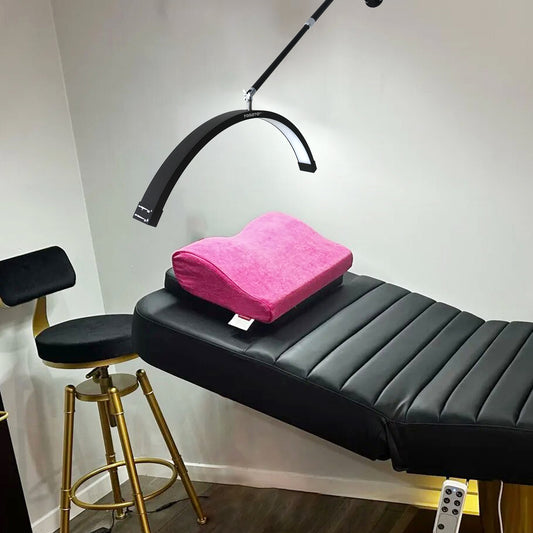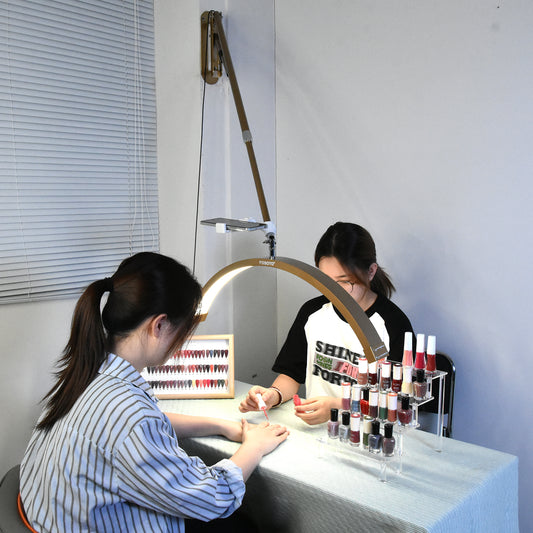
The Art of Illumination: Why Lighting Is Your Salon’s Most Powerful Design Tool
Share
How Lighting Shapes Your Salon’s Identity
When clients step into your salon, they don’t just see chairs and mirrors — they feel an experience. And one of the most powerful invisible forces shaping that experience is light. As we move into 2026, lighting is no longer just functional — it’s a core design ingredient that communicates your brand, supports your artists, and defines how clients perceive and enjoy the space.
Here are five lighting-driven trends that are transforming salon interiors — and how you can lean into them to make your salon more than just a place to get beautified.
1. Sculptural Lighting as a Signature Statement
In 2026, lighting fixtures aren’t just tools — they’re sculptural art pieces. Designers are favoring bold, custom silhouettes, blending materials like glass, metal, and stone to create visual centerpieces. Castro
-
Why it matters for salons: A beautifully crafted pendant or wall fixture can serve as a design focal point, reinforcing your salon’s personality and elevating the space into a curated gallery.
-
How to use it: Choose one or two standout lighting elements in reception, styling zones, or waiting areas. Let these pieces do double duty: lighting + brand expression.
2. Warm, “Gentle Glow” Ambient Lighting
Rather than harsh downlights or overly bright LEDs, the trend is shifting toward soft, warm illumination that feels calm and intimate. Homes and Gardens
-
Why it matters for salons: Clients often come in to relax, be pampered, or escape the outside world. A gentle glow helps foster a soothing, inviting atmosphere.
-
How to use it: Layer your lighting — combine diffuse ceiling sources with dimmable task lights at stations. Offer lighting that transitions from more functional (for the stylist) to more ambient (for the client).
3. Mixed-Material Fixtures for Luxurious Depth
Lighting isn’t just about metal or glass anymore. Designers are now combining materials — marble with metal, glass with textured textile shades — to create warm, tactile designs. Homes and Gardens
-
Why it matters for salons: Mixed-material fixtures introduce richness and craftsmanship. They make the space feel more intentional and less like a generic commercial setup.
-
How to use it: Use mixed-material lights to highlight architectural elements — perhaps a marble-and-fabric sconce near a styling station, or a woven-texture pendant in the retail nook.
4. Custom, Brand-Aligned Lighting (Goodbye Generic)
One big trend for 2026 is goodbye convention, hello custom. Lighting is becoming personalized — not just in color or brightness, but in shape and finish. Homes and Gardens
-
Why it matters for salons: Custom fixtures let you embed your brand identity into your space in a meaningful way. It’s not just “a lamp,” it’s your lamp.
-
How to use it: Work with lighting designers (or brands) to create pieces that reflect your salon’s story — maybe a signature pendant shape, or a custom-finished metal fitting that aligns with your salon’s color palette.
5. Smart & Energy-Efficient Lighting That Reads the Room
Smart lighting continues to rise. Integrated IoT fixtures can adapt color temperature or brightness based on time of day, activity, or mood. Accio
-
Why it matters for salons: Whether it’s appointment-heavy mornings or relaxing late-afternoon clients, lighting that adapts can improve comfort, reduce energy use, and support different service types.
-
How to use it: Install dimmable LEDs, use programmable lighting zones, or choose smart panels that allow you to control light intensity and warmth with an app or voice command.
— Why Lighting Is Now Central to Salon Branding & Experience
-
First impressions: Lighting is often the first thing a client notices — a well-lit reception area sets a tone of professionalism and care.
-
Work quality: For stylists, lash artists, makeup artists, or colorists, the right lighting directly affects precision and satisfaction.
-
Mood and well-being: Thoughtful ambient lighting makes clients feel at ease. Smart lighting can support wellness by simulating natural light rhythms.
-
Sustainability: Choosing energy-efficient LEDs and smart systems not only lowers running costs, but also aligns with eco-conscious brand values. The Pinnacle List+1
-
Brand signature: Custom or sculptural lighting is a physical expression of your salon’s identity — it’s part of your visual story.
Bringing It to Life: Tips for Salon Owners
-
Start with your brand story: What feeling do you want lighting to communicate — calm luxury, creative edge, or wellness sanctuary?
-
Use a lighting layer plan: Combine ambient, task, and accent lighting to balance aesthetics with functionality.
-
Invest in quality fixtures: Thoughtful materials and custom shapes pay off in long-term brand value.
-
Leverage technology: Use smart lighting to adapt to service types, time of day, and energy savings.
-
Work with a lighting designer or specialist: Collaborate with someone who understands both interior design and salon workflow — lighting isn’t just decoration, it’s a performance tool.
Final Thought
As salons evolve beyond simple service environments, lighting is becoming a foundational part of the brand experience — not just for looks, but for atmosphere, performance, and sustainability. In 2026, the right lighting does more than illuminate: it tells your story. By embracing sculptural forms, warm ambient glow, rich materials, and smart technology, you can turn your salon interior into a space that feels intentionally yours and that deepens your connection with every client who walks through the door.








